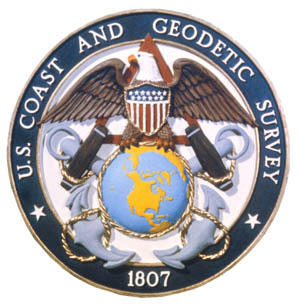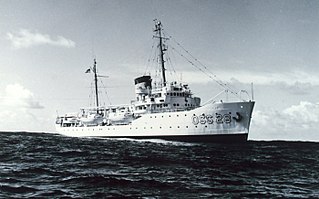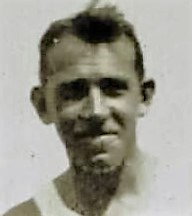
The United States Coast and Geodetic Survey, known from 1807 to 1836 as the Survey of the Coast and from 1836 until 1878 as the United States Coast Survey, was the first scientific agency of the United States Government. It existed from 1807 to 1970, and throughout its history was responsible for mapping and charting the coast of the United States, and later the coasts of U.S. territories. In 1871, it gained the additional responsibility of surveying the interior of the United States and geodesy became a more important part of its work, leading to it being renamed the U.S. Coast and Geodetic Survey in 1878.

USC&GS A. D. Bache (1901-1927), often referred to only as Bache, continued the name of the Bache of 1871 and has been confused, including in the Dictionary of American Naval Fighting Ships, with that ship even though an entirely new hull and boiler were built in 1901 and only the name and some machinery and instruments were transferred to the new hull. The Bache of 1901 was transferred to the U.S. Navy for World War I service between 24 September 1917 through 21 June 1919 when she was returned to the Coast and Geodetic Survey.

USC&GS Carlile P. Patterson was a survey ship of the United States Coast and Geodetic Survey in operation between 1883 and 1918. Subsequently, she had a brief period of naval service and fifteen seasons as a merchant vessel before she was wrecked on the Alaska coast in 1938.

USS Mobjack (AVP-27/AGP-7) was a motor torpedo boat tender in commission in the United States Navy from 1943 to 1946. She saw service in the Pacific theater during the latter portion of World War II.
USC&GS Arago was a survey ship that served in the United States Coast Survey from 1854 to 1878 and in the United States Coast and Geodetic Survey from 1878 to 1881. From October 1861 into 1863 Arago was at times attached to the Navy's South Atlantic Blockading Squadron off South Carolina to provide hydrographic support. She was the first ship of the Coast Survey or Coast and Geodetic Survey to bear the name.

USC&GS Natoma was built as the private motorboat Natoma in 1913 for Charles H. Foster, President of the Cadillac Motor Car Company of Chicago. In 1917 the United States Navy acquired the boat for use in World War I. The vessel was commissioned USS Natoma for Section Patrol duties and designated SP-666. Natoma spent the war years patrolling New York harbor and approaches. On 9 April 1919 the boat was transferred to United States Coast and Geodetic Survey surveying on both coasts until 1935.

Gilbert T. Rude (1881–1962) was an officer in the United States Coast and Geodetic Survey—one of the ancestor organizations of the United States National Oceanic and Atmospheric Administration (NOAA) -- and the United States Navy. He served as Chief of the Division of Coastal Surveys in the Coast and Geodetic Survey. A NOAA ship was named for him.

USC&GS Matchless was a wood, two masted schooner that served as a survey ship in the United States Coast and Geodetic Survey from 1885 to 1919. She was the only Coast and Geodetic Survey ship to bear the name and the last sailing vessel owned and operated by the Survey.

USC&GS Isis was a survey ship that served in the United States Coast and Geodetic Survey from 1915 to 1917 and from 1919 to 1920.

The second USC&GS Fathomer was a steamer that served as a survey ship in the United States Coast and Geodetic Survey from 1905 to 1942.

USC&GS Marinduque was a steamer, owned by the Philippine Insular Government, that served exclusively in the Philippines. The ship was purchased by the Philippine Bureau of Coast Guard and Transportation to support both government logistical and administrative travel needs as well as the usual functions of a coast guard vessel. The vessel was transferred to the United States Coast and Geodetic Survey serving as a survey ship from 1905 to 1932. Marinduque and Romblon were sister ships, both built in Japan.

USC&GS Romblon was a steamer, owned by the Philippine Insular Government, that served exclusively in the Philippines. The ship was purchased by the Philippine Bureau of Coast Guard and Transportation to support both government logistical and administrative travel needs as well as the usual functions of a coast guard vessel. The vessel was transferred to the United States Coast and Geodetic Survey serving as a survey ship from 1905 to 1932. Romblon and Marinduque were sister ships, both built in Japan.

The first USC&GSS Pathfinder, also noted in some NOAA histories as "old Pathfinder", was a United States Coast and Geodetic Survey ship in service from 1899 to 1941, when she was beached in sinking condition on January 30, 1942, after 40 years service in the Philippines.

USC&GS A. D. Bache (1871–1900), the second steamer of the U.S. Coast and Geodetic Survey, was named for the former superintendent Alexander Dallas Bache and launched August 1871 at Wilmington, Delaware.

USS Onward (SP-311), a former yacht named Galatea and then Ungava was a patrol yacht acquired by the U.S. Navy during World War I. She was transferred to the U.S. Coast and Geodetic Survey where she served briefly until return to the Navy for a brief time before her disposal by sale. She was renamed Thelma Phoebe.

The first USC&GS Explorer was a steamer that served as a survey ship in the US Coast & Geodetic Survey (USCGS) from 1904-1939 with brief time 1918-1919 assigned to Navy for patrol in Alaskan waters. After initial service in the Atlantic the ship transferred to Seattle in 1907 to begin survey work in Alaskan waters during summer and more southern waters in winter. On return from the Navy the ship was condemned and due to be sold. Instead the ship was retained as a survey vessel into the fall of 1939 and existed into World War II when it saw service with the United States Army Corps of Engineers as Atkins.

The second USC&GS Explorer was a survey ship that served in the United States Coast and Geodetic Survey from 1940 to 1968. She operated in the Pacific Ocean from 1940 to 1960, seeing service there during World War II, and in the Atlantic Ocean from 1960 to 1968.

Rear Admiral Raymond Stanton Patton was the second Director of the United States Coast and Geodetic Survey and a career officer in the United States Coast and Geodetic Survey Corps, the predecessor of the National Oceanic and Atmospheric Administration Commissioned Officer Corps. He was the first Coast and Geodetic Survey Corps officer to reach flag rank.

Rear Admiral Robert Francis Anthony Studds was a career officer in the United States Coast and Geodetic Survey Corps, predecessor of the National Oceanic and Atmospheric Administration Commissioned Officer Corps. He served as the fourth Director of the United States Coast and Geodetic Survey.

USS Helianthus (SP-585) was a patrol vessel in commission in the United States Navy from 1917 to 1919, seeing service in World War I. After her U.S. Navy service, she was in commission in the United States Coast and Geodetic Survey as the survey launch USC&GS Helianthus from 1919 to 1939. She was named after the Helianthus, the genus to which the sunflower belongs.



















